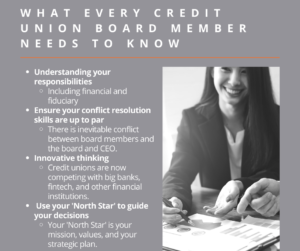


At Newcleus CU Advisors, we have come into contact with plenty of credit union board members, CEOs, and CFOs. In this time, we’ve discovered that sometimes the board members need a little guidance on what they need to know when they begin working with the credit union. Like any new role, becoming a member of the board can be overwhelming.
NCUA provides guidance on becoming a board member, which can be found here. However, we believe firsthand experience can provide a unique insight into what actually happens in the boardroom.
In an effort to help board members across all credit unions, we sat down with Mark Werner, Board Chairman at Quorum Federal Credit Union, to get his take on what board members need to know as they consider joining a credit union.
Mark has been a member of the board for 20-25 years and now holds the title of Board Chairman at Quorum Federal Credit Union. He is also on the board of trustees for a key retirement plan offered by CUNA. His insight is extremely valuable, as he has the experience needed to understand the board experience as a whole.
Understanding your responsibilities.
As you consider becoming a board member, it’s important to understand the responsibility you are taking on. This includes a financial responsibility to your members, as well as a fiduciary responsibility. Mark explains “typically we look for existing members of the credit union to become part of the board.” Understanding the concept of a credit union is key.
Previously, Mark contacted members with little to no credit union background, and the biggest hurdle became understanding the concept of a credit union. At its most basic level, a credit union is owned by its members. Every decision made relates back to the members’ best interest.
The major advantage of being on a credit union board is that you get to make changes and react to the business environment and other opportunities quicker than large business boards. You see a direct result of your decisions in real-time. There’s also a feel-good aspect of being a part of a credit union board. As Mark says, “being on the board, you’re with an institution that is providing service with a personal touch.” You are able to provide key solutions that are directly related to your member’s key issues.
As far as decision-making goes, the CEO drives most of the decisions for your credit union. They form the annual budget, the structure of the organization, and are responsible for other logistical decisions, and the board will hold approval over the plans. Board members have a “fiduciary responsibility to make sure plans are properly presented.” The CEO has control over most compensation- cash compensation, deferred compensation, etc.- however, the board is responsible for overseeing these decisions.
One of the key responsibilities of a board is to ensure a succession plan is in place for the organization. The execution of this plan is a shared responsibility. As a board, you need to put a plan in place for the successor to the CEO. Who is it? What is their development? Are they on track? If not, how can we get them on track?
The positions below the CEO, fall under the CEO’s responsibility. A key role that is often forgotten is the Vice President of Human Resources. The board needs to ensure the VP of Human Resources is a top performer. Typically boards focus on the financial roles of the organization, and HR roles tend to fall into the background. However, an impeccable VP HR can make a huge difference for your succession planning and your organization as a whole.
“Appreciate the main functions of the leadership team, however, don’t lose sight of the other roles that impact the credit union.”
Conflict resolution skills are necessary. 
As you aspire to become a board member, you should be keenly aware of the inevitable conflict between board members and the CEO, as well as between board members. The board/CEO relationship depends largely on the culture and people within your unique credit union, so it’s important to simply be prepared for whatever comes your way. This largely depends on your relationship with your members, and how they communicate the impact of the CEO’s decision-making.
Conflict between board members can be a little different. Bringing together a variety of people with different backgrounds will almost always lead to some level of conflict.
Mark, with an impressive financial background, says “you’re going to be listening to people who might not have a strong financial background, which is largely the topic of conversation, so it’s important to know when to listen and when to speak up. If your area of expertise is within the finance world, speak up, it will truly provide valuable input. If the topic of conversation is outside of your area of expertise, try listening to the other points of view in the room.”
Understanding the basics of conflict resolution is key to your success as an individual board member, as well as to the board as a whole. There is a way to create constructive conflict to help members, who may be more traditional in their habits and thinking, come out of their comfort zone. “You should expect exciting board meetings, if they’re boring and your board is just going through the motions, your board is not working hard enough.” Conflict is key to driving your credit union forward, as long as it’s constructive and brings about important conversations.
Innovative thinking is key.
Mark’s credit union has gone completely digital. They officially closed their final remaining branch in the last year, and everything has changed for their credit union. “One of my board members put it nicely, we are now an information technology firm that happens to be in the finance industry.” It’s important to know how technology has transformed the business and where this technology might be headed for credit unions.
“Corporate benevolence doesn’t exist anymore. We are now competing with big banks, fintech, and other financial institutions to attract new members.” Board members need to be hyper-aware of what is changing in the market, how fast it’s changing, and how your credit union can and should change with it.
If you engage with a credit union whose executive team is still talking about what they were talking about 10 years ago, you have an issue on your hands. Use your voice to speak up about the progress that will need to be made in order to remain competitive in the market. Even if you don’t have an in-depth financial background, your key role as a board member is to be BOLD and challenge the thinking of your team.
What should you look for in the future?
“Our biggest fear right now is becoming a back-office warehouse institution. Meaning money comes into the credit union, only to be immediately taken out to be used in other ways, through Venmo, Paypal, etc.
If this happens, our usefulness as a credit union diminishes. We are currently wrestling over how to maintain value to our members, as well as thinking about new products and services to offer our current and future members. The credit union today needs to be very different than the credit union you knew 15 years ago.”
Using your ‘North Star’ to guide your decisions.
Your ‘North Star’ is your mission, values, and your strategic plan that guides every decision you make as a credit union. Your mission needs to be clear, understood, and tested often. “As new changes and different opportunities come your way, you need that North Star to guide you toward what is most impactful for your credit union.”
It’s also extremely important to continuously quality check your mission and vision. Do they still make sense? Are they still relevant to our membership? Are they still helpful in guiding our decisions? This quality check should be done multiple times throughout the year, not simply one day in June that is set on the calendar.

